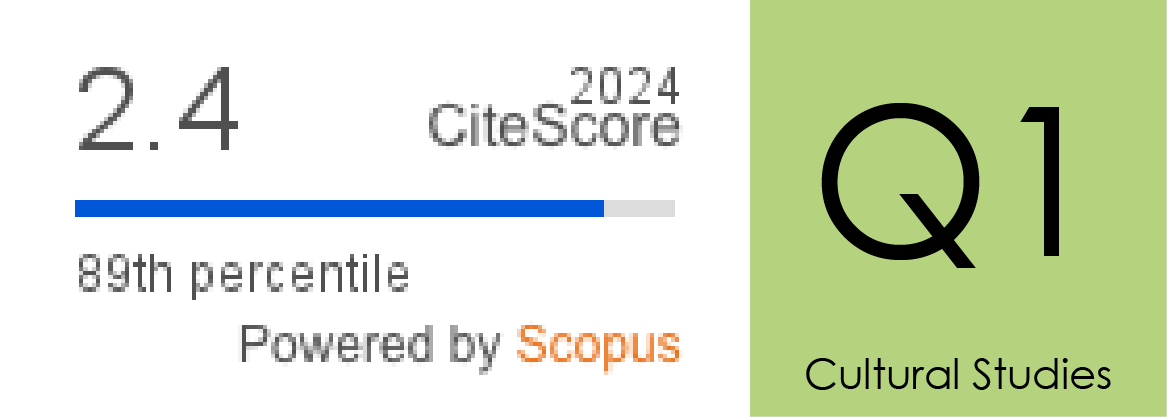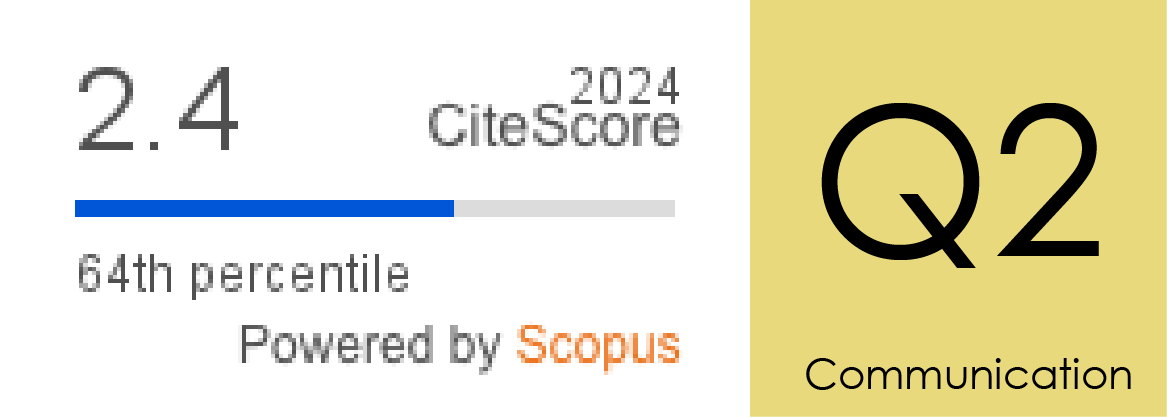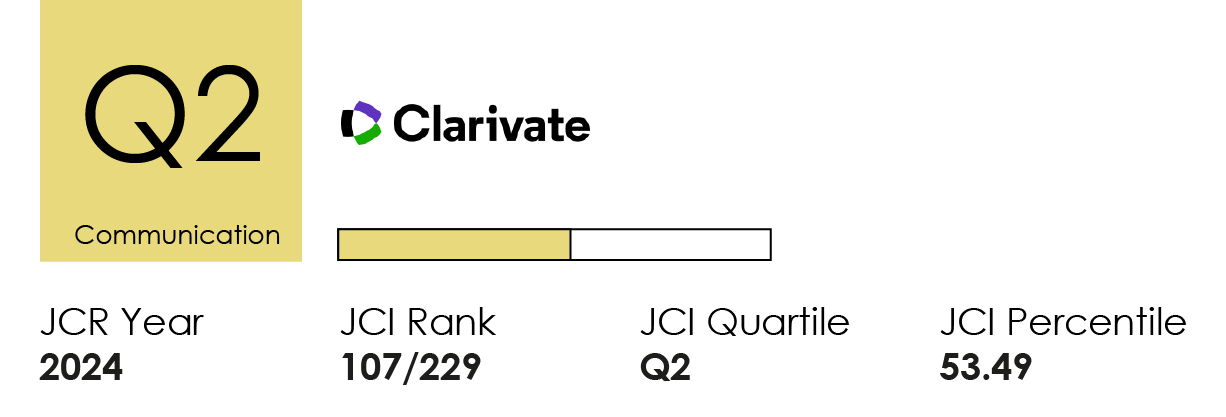Descolonización de la música en TikTok: “¡Hagamos un dúo!”
DOI:
https://doi.org/10.14198/MEDCOM.24949Palabras clave:
música transmedia, descolonización, TikTok, industria cultural, dúo, versión musicalResumen
En la actualidad, redes sociales como TikTok están transformando el modo en que se expanden las narrativas musicales por el mundo. En esta aplicación de micro-vídeos eminentemente musicales, se comparten diariamente diversidad de contenidos creativos que no se alejan de los contextos socioculturales de sus usuarios. En este sentido, la plataforma facilita la creación de contenido “migrante” no occidental, integrando valores que reflejan el crecimiento cultural, social, rural y oriental. Con base en 510 dúos musicales generados por los usuarios de TikTok, este estudio explora cómo la plataforma potencia la descolonización de la industria musical, gobernada hasta entonces por estudios de grabación occidentales. Se desarrolla un análisis semiótico para explorar el contenido generado por el usuario en torno al reto #SingWithMe. Los resultados apuntan hacia un proceso de redescubrimiento y recuperación, sueño, compromiso y acción para la emancipación industrial. Se concluye que el dúo de TikTok es una herramienta clave que despierta una suerte de descentralización popular inconsciente dirigida por los usuarios.
Financiación
Este estudio ha sido financiado por el Ministerio de Universidades de España a través de la Ayuda del Programa de Formación de Profesorado Universitario (FPU) (REF. FPU18/00892), dentro del programa de Promoción del Talento y su Empleabilidad, en el marco del Plan Estatal de Investigación Científica y Técnica y de Innovación 2017-2020 en I+D+i. Asimismo, el tiempo dedicado a esta investigación se engloba en la ‘TikTok Cultures Research Network’ y el ‘Influencer Etnography Research Lab’ (IERLab) de la Curtin University (Australia).Citas
Abidin, C., & Kaye, D. B. V. (2021). Audio memes, earworms, and templatability: The ‘aural turn’ of memes on TikTok. In C. Arkenbout, J. Wilson, y D. De-Zeeuw (Eds.), Critical meme reader: Global mutations of the viral image (pp. 58-68). Institute of Network Cultures. https://bit.ly/3hqMQKu
Acey, C. E., Bouterse, S., Menking, A., Sengupta, A., & Vrana, A. G. (2021). Decolonizing the Internet by decolonizing ourselves: Challenging epistemic injustice through feminist practice. Global Perspectives, 2(1), 1-9. https://doi.org/10.1525/gp.2021.21268
Admadja, D. (2022). Juridical analysis of music uploaded on TikTok media in view of intellectual property law. International Asia of Law and Money Laundering, 1(3), 193-197. https://bit.ly/3YgavRO
Arrieta, A. (2021). ‘This audio has potential’: Platform lip-sync on TikTok. Journal of Popular Music Studies, 33(4), 5-9. https://doi.org/10.1525/jpms.2021.33.4.5
Born, G., & Hesmondhalgh, D. (2000). Western music and its others: Difference, representation, and appropriation in music. University of California Press.
Carr, M. (2015). Power plays in global Internet governance. Millennium: Journal of International Studies, 43(2), 640-659. https://doi.org/10.1177/0305829814562655
Collie, N., & Wilson-Barnao, C. (2020). Playing with TikTok: Algorithmic culture and the future of creative work. In G. Hearn (Ed.), The future of creative work (pp. 172-188). https://doi.org/10.4337/9781839101106.00020
Coulter, A. (2022). Marketing agile artists: How music labels can leverage TikTok’s virality. Journal of the Music & Entertainment Industry Educators Association, 22(1), 135-156. https://doi.org/10.25101/22.5
Darvin, R. (2022). Design, resistance and the performance of identity on TikTok. Discourse, Context & Media, 46. https://doi.org/10.1016/j.dcm.2022.100591
Dunn, K. (2012). 'We are the revolution': Riot Grrrl press, girl empowerment, and DIY self-publishing. Women's Studies, 41(2), 136-157. https://doi.org/10.1080/00497878.2012.636334
Eco, U. (1976). A theory of semiotics. Indiana University Press.
Edmond, M. (2014). Here we go again: Music videos after YouTube. Television & New Media, 15(4), 305-320. https://doi.org/10.1177/1527476412465901
Gillespie, T. (2017). Algorithmically recognizable: Santorum’s Google problem, and Google’s Santorum problem. Information, Communication & Society, 20(1), 63-80. https://doi.org/10.1080/1369118X.2016.1199721
Glïck, A. (2018). De-Westernization and decolonization in media studies. Oxford Research Encyclopedias, 1-29. https://doi.org/10.1093/acrefore/9780190228613.013.898
Gorwa, R., Binns, R., & Katzenbach, C. (2020). Algorithmic content moderation: Technical and political challenges in the automation of platform governance. Big Data & Society, 7(1). https://doi.org/10.1177/2053951719897945
Guerrero-Pico, M., y Scolari, C. A. (2016). Narrativas transmedia y contenidos generados por los usuarios: El caso de los crossovers. Cuadernos.info, 38, 183-200. https://doi.org/10.7764/cdi.38.760
Hesmondhalgh, D., Jones, E., & Rauh, A. (2019). SoundCloud and Bandcamp as alternative music platforms. Social Media + Society, 1-13. https://doi.org/10.1177/2056305119883429
Hidalgo-Marí, T., & Sánchez-Olmos, C. (2016). Fanáticas en serie: YouTube, cultura participativa y series de televisión: Estudio comparativo de género. Cuadernos.info, 38, 149-164. https://doi.org/10.7764/cdi.38.733
Homer, M. (2009). Beyond the studio: The impact of home recording technologies on music creation and consumption. Nebula, 6(3), 85-99. https://bit.ly/3r8Ino9
Jaramillo-Dent, D., Alencar, A., & Asadchy, Y. (2022). #Migrantes on TikTok: Exploring platformed belongings. International Journal of Communication, 16, 5578-5602. https://bit.ly/3yy2jRv
Jaramillo-Dent, D., Contreras-Pulido, P., & Pérez-Rodríguez, A. (2022). Immigrant influencers on TikTok: Diverse microcelebrity profiles and algorithmic (in)visibility. Media and Communication, 10(1), 208-221. https://doi.org/10.17645/mac.v10i1.4743
Jarrett, K. (2008). Beyond Broadcast Yourself™: The future of YouTube. Media International Australia, 126(1), 132-144. https://doi.org/10.1177/1329878X0812600114
Jia, L., & Liang, F. (2021). The globalization of TikTok: Strategies, governance and geopolitics. Journal of Digital Media & Policy, 12, 273-292. https://doi.org/10.1386/jdmp_00062_1
Jones, E. (2021). DIY music and the politics of social media. Bloomsbury Academic. https://doi.org/10.5040/9781501359675
Jones-Jang, S. M., & Chung, M. (2022). Can we blame social media for polarization? Counter-evidence against filter bubble calims during the COVID-19 pandemic. New Media & Society. https://doi.org/10.1177/14614448221099591
Kaye, D. B. V. (2022). Please duet this. Collaborative music making in lockdown on TikTok. Networking Knowledge: Journal of the MeCCSA Postgraduate Network, 15(1), 1-19. https://bit.ly/409AH1P
Karhade, P., Kathuria, A., Dasgupta, A., Malik, O., & Konsynski, B. (2021). Decolonization of digital platforms: A research agenda for great domains. In A. Garimella, P. Karhade, A. Kathuria, X. Liu, & J. Xu (Eds.), The role of e-business during the time of grand challenges (pp. 51-58). WeB: Workshop on E-Business. https://doi.org/10.1007/978-3-030-79454-5_5
Laenui, P. (2006). Processes of decolonization. In M. A. Battiste (Ed.), Reclaiming indigenous voice and vision (pp. 150-160). UBC Press.
Leman, M. (2016). The expressive moment. How interaction (with music) shapes human empowerment. The MIT Press.
Light, B., Burgess, J., & Duguay, S. (2016). The walkthrough method: An approach to the study of apps. New Media & Society, 20(3), 881-900. https://doi.org/10.1177/1461444816675438
Ma, Y., & Hu, Y. (2021). Business model innovation and experimentation in transforming economies: ByteDance and TikTok. Management and Organization Review, 17(2), 382-388. https://doi.org/10.1017/mor.2020.69
Meighan, P. J. (2021). Decolonizing the digital landscape: The role of technology in indigenous language revitalization. AlterNative, 17(3), 397-405. https://doi.org/10.1177/11771801211037672
Mirzoeff, N., & Halberstam, J. (2018). Decolonize media: Tactics, manifestos, histories. Cinema Journal, 57(4), 120-123. https://doi.org/10.1353/cj.2018.0054
Navarro-Güere, H. (2023). El vídeo em formato vertical. Una revisión de la literatura en comunicación. Revista Mediterránea de Comunicación/Mediterranean Journal of Communication, 14(1), 69-80. https://doi.org/10.14198/MEDCOM.23028
Radovanović, B. (2022). TikTok and sound: Changing the ways of creating, promoting, distributing and listening to music. Journal of Contemporary Music, Art and Technology, 9, 51-73. https://doi.org/10.51191/issn.2637-1898.2022.5.9.51
Rogers, H., Freitas, J., & Porfírio, J. F. (2023). YouTube and music. Online culture and everyday life. Bloomsbury Academic. https://doi.org/10.5040/9781501387302
Sanders-Pierce, C. (2006). The sign: Icon, index, and symbol. In S. Manghani, A. Piper, & J. Simons (Eds.), Images: A reader (pp. 107-109). Sage Publications.
Sadler, O. (2022). Defiant amplification or decontextualized commercialization? Protest music, TikTok, and social movements. Social Media + Society, 1-10. https://doi.org/10.1177/20563051221094769
SensorTower. (2019). Top apps worldwide for September 2019 by Downloads. SensorTower. https://bit.ly/445vNnY
Shepard, T. (2019). Foreword. In M. Thurner (Ed.), The first wave of decolonization (pp. 7-11). Routledge.
Spivak, G. C. (1988). Can de subaltern speak? In C. Nelson, & L. Grossberg (Eds.), Marxism and the interpretation of culture (pp. 66-111). Macmillan. https://bit.ly/437idPR
Syed-Mustafa, A. (2018). Prolegomenon to the decolonization of Internet governance. In D. Oppermann (Ed.), Internet governance in the global south: History, theory and contemporary debates (pp. 109-183). NUPRI. https://bit.ly/3WK59wz
Toffler, A. (1980). La tercera ola. Plaza & Janés.
Vizcaíno-Verdú, A., Aguaded, I., & Contreras-Pulido, P. (2021). Understanding transmedia music on YouTube through Disney storytelling. Sustainability, 13, 1-17. https://doi.org/10.3390/su13073667
Vizcaíno-Verdú, A., & Abidin, C. (2022). Music challenge memes on TikTok: Understanding in-group storytelling videos. International Journal of Communication, 16(26), 883-908. https://bit.ly/3EkoQVU
Vizcaíno-Verdú, A., & Aguaded, I. (2022). #ThisIsMeChallenge and music for empowerment of marginalized groups on TikTok. Media and Communication, 10(1), 157-172. https://doi.org/10.17645/mac.v10i1.4715
Vizcaíno-Verdú, A., de-Casas-Moreno, P., & Tirocchi, S. (2023). Online prosumer convergence: Listening, creating and sharing music on YouTube and TikTok. Communication & Society, 36(1), 151-166. https://doi.org/10.15581/003.36.1.151-166
Wang, Y. H., Gu, T. J., & Wang, S. L. (2019). Causes and characteristics of short video platform Internet-community taking the TikTok short video application as an example. In 6th IEEE International Conference on Consumer Electronics (pp. 1-7). IEEE.
Webb-Gannon, C., & Webb, M. (2019). ‘More than a music, it’s a movement’: West Papua decolonization songs, social media, and the remixing of resistance. The Contemporary Pacific, 31(2), 309-343. https://doi.org/10.1353/cp.2019.0025
Zeng, J., & Kaye, D. B. V. (2021). From content moderation to visibility moderation: A case study of platform governance on TikTok. Policy Internet, 14, 79-95. https://doi.org/10.1002/poi3.287
Zulli, D., & Zulli, D. J. (2020). Extending the Internet meme: Conceptualizing technological mimesis and imitation publics on the TikTok platform. New Media & Society, 24(8), 1872-1890. https://doi.org/10.1177/1461444820983603
Descargas
Estadísticas
Publicado
Cómo citar
Número
Sección
Licencia
Derechos de autor 2023 Arantxa Vizcaíno-Verdú

Esta obra está bajo una licencia internacional Creative Commons Atribución 4.0.
Los autores y autoras que publican en esta revista están de acuerdo con los siguientes términos:
1 Derechos de autor. Los autores y autoras conservan sus derechos de autor, aunque ceden a la revista de forma no exclusiva los derechos de explotación (reproducción, distribución, comunicación pública y transformación) y garantizan a esta el derecho de primera publicación de su trabajo, el cual estará simultáneamente sujeto a la licencia indicada en punto 2. Los autores pueden establecer otros acuerdos adicionales para la distribución no exclusiva de la versión de la obra publicada en la revista, siempre que exista un reconocimiento de su publicación inicial en esta revista.
© Los autores.
2 Licencia. Los trabajos se publican en la revista sujetos a la licencia de Reconocimiento 4.0 Internacional de Creative Commons (CC BY 4.0); los términos se pueden consultar en https://creativecommons.org/licenses/by/4.0/
Esta licencia permite a terceros compartir (copiar y redistribuir el material en cualquier medio o formato) y adaptar (remezclar, transformar y crear a partir del material para cualquier finalidad, incluso comercial), siempre que se reconozca la autoría y la primera publicación en esta revista (Revista Mediterránea de Comunicación (RMC) / Mediterranean Journal of Communication (MJC), Universidad de Alicante, DOI de la obra), se proporcione un enlace a la licencia y se indique si se han realizado cambios en la obra.
3 Política de autoarchivo. Se recomienda a los autores que difundan sus trabajos a través de Internet para favorecer una circulación y difusión más rápidas y, con ello, un posible aumento en la citación y alcance entre la comunidad científica y académica, en las siguientes condiciones:
No se permite a los autores depositar en un repositorio institucional o temático, página web propia, etc., las versiones preprint (versión antes de ser evaluada) o postprint (versión evaluada y aceptada para su publicación) de sus trabajos antes de su publicación, pero sí el artículo final publicado (versión del editor).













